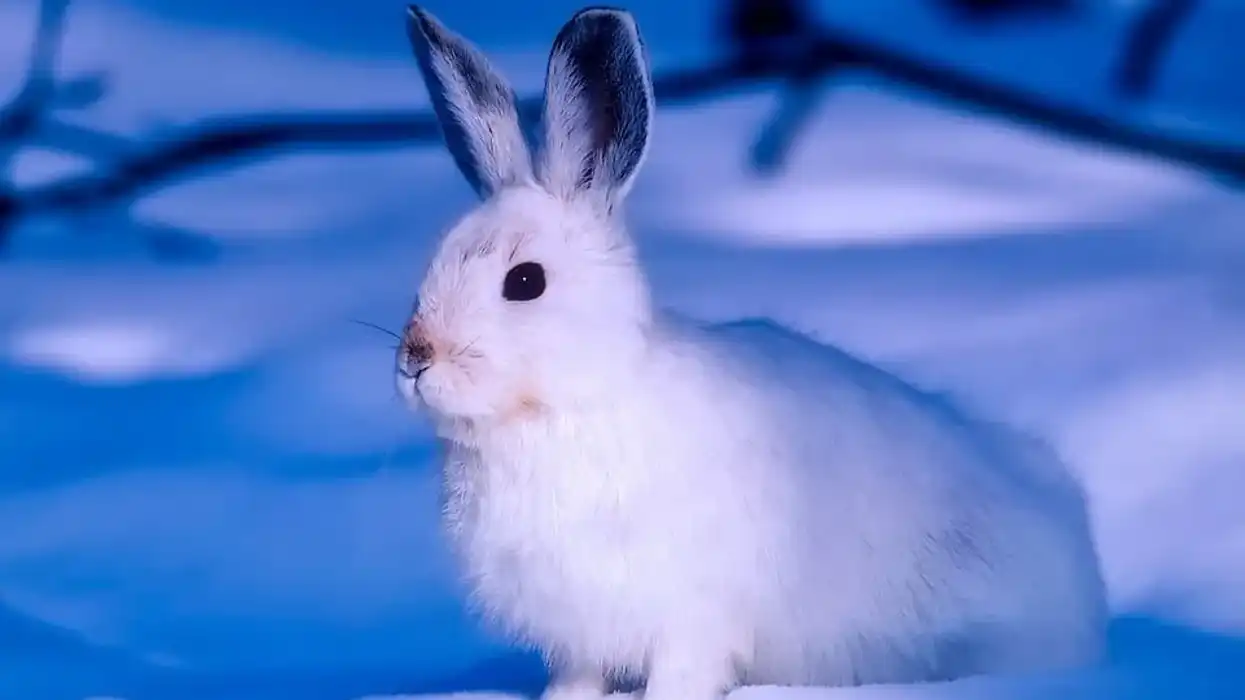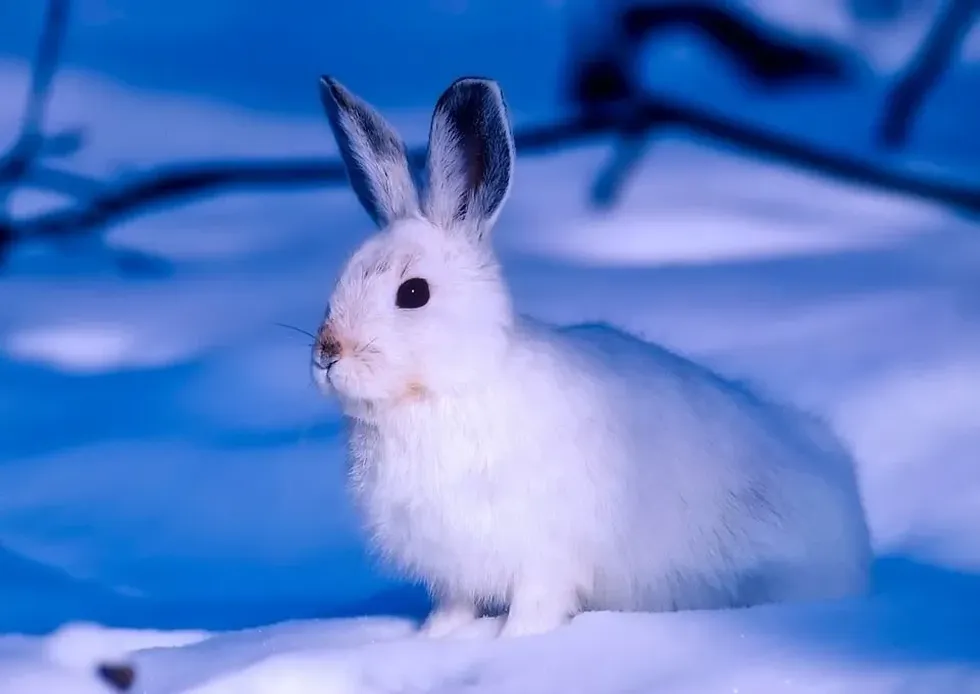The hispid hare (scientific name: Caprolagus hispidus), also called bristly rabbit or Assam rabbit, is one of the least studied small mammal species in the world. Native to South Asian countries like Nepal, India, Bangladesh, and Bhutan, the hispid hare is a leproid species belonging to the family Leporidae and order Lagomorpha.
The hispid hare is the only living species in the genus Caprolagus. The animal is identified by its remarkably short ears and distinctively short hind legs, a sharp contrast to other species of the same family.
Moreover, the hispid hare behavior is extremely shy and cryptic in nature, one of the main reasons why this hare species remains one of the least-investigated in the world.
The animal rarely comes out of its natural habitat comprising mostly of tall elephant grasses. As a result, its secretive and elusive nature makes it challenging to detect its presence, let alone details of its lifestyle.
Historically, the distribution range of the bristly rabbit covered extensive regions of tall grassland habitats along the southern foothills of the mighty Himalayan mountains. This grassland habitat included much of the Terai region in northern India and southern Nepal, Bhutan, Bengal, Sikkim, and the floodplain grasslands of northern Bangladesh and northeastern India, including Assam.
Its diet consists of shoots, bark, roots of grasses, thatch, and occasionally crops.
A combination of several factors such as habitat destruction, hunting, the succession of grassland areas into woodlands, climate change, burning thatch, and invasive species have led to a rapid decline in populations of the bristly rabbit in most of its range.
The species is currently very rare, endangered, and only occur as small, isolated populations in southern Nepal, northern India, and parts of Assam in northeastern India.
Read on for more interesting facts about the hispid hares of South Asia!
If you like what you read, check out other interesting articles about animals such as the waterbuck and takin.
Hispid Hare Interesting Facts
What type of animal is a hispid hare?
Hispid hare (Caprolagus hispidus) is an endangered species of hare in the family Leporidae. Also known as Assam rabbit and bristly rabbit, the hispid hares are native to the countries of India, Nepal, Bhutan, and Bangladesh in South Asia and are found along the southern foothills of the Himalayas.
What class of animal does a hispid hare belong to?
Hispid hares belong to the class of Mammalia.
How many hispid hares are there in the world?
The present estimate of the hispid hare (Caprolagus hispidus) population in the wild is not available. This is partly due to the elusive nature of the species that makes studying it extremely difficult.
Besides, hunting and natural habitat destruction has led to a sharp decline in the population of the Assam rabbit, affording it Endangered status in the International Union for Conservation of Nature (IUCN) Red List of Threatened Species. It is said that the world population of this enigmatic species has been reduced to a few hundred individuals.
Where does a hispid hare live?
The hispid hare (Caprolagus hispidus) is native to the South Asian countries of India, Nepal, Bhutan, and Bangladesh.
Looking back at its distribution history, the range of the hispid hares included the southern foothills of the Himalayas encompassing the Indian states of Uttar Pradesh, West Bengal, Bihar, and Assam, Nepal, and south, to Bangladesh.
Evidence of the species has also been found in the southern foothills of Bhutan. However, human activities have wiped out the species from most of its habitat range.
As per the latest survey conducted in the 1990s, fragmented wild populations of the endangered bristly rabbit have been recorded in Assam, northwest Bihar, northwest Bengal, Uttar Pradesh, Madhya Pradesh, and the Terai region of southern and southwestern Nepal.
What is a hispid hare's habitat?
The hispid hare (Caprolagus hispidus) prefers a habitat abundant in tall grasslands, commonly called elephant grass. These tall grasslands are characteristic of savannah habitats, flat and well-drained.
The hispid hare thrives best in areas abundant with riverine vegetation comprising dense and tall grass or elephant grass that grows to a height of more than 10 ft (3.1 m) during the monsoon season.
When the grasslands become way too waterlogged at the peak of the monsoon season, the hispid hare shifts to the forested foothills.
Likewise, when the grassland or forest areas are set on fire, the hares take refuge in the foothills, on the banks of dried-up streams, or cultivated fields. There has been no report of the hispid hare building nests or burrows.
Who does hispid hare live with?
The hispid hare is supposedly a solitary animal and is occasionally seen in male-female pairs, perhaps during the breeding season. They are nocturnal and are most active at dawn and dusk.
How long does a hispid hare live?
No data is available regarding the hispid hare's lifespan in the wild. The animal has not lived for long in captivity either.
How do they reproduce?
Knowledge about the hispid hare reproductive process is very scarce. Based on the capture of pregnant females in the wild, the breeding season of the hispid hare is supposed during late winter or early spring.
The litter size ranges between two to five offspring, with the possibility of production of around up to nine litters per year.
Birthing usually occurs between January and March. Most females in the family Leporidae have a gestation period ranging between 25-30 days, with the capability to give birth to several litters in a year.
What is their conservation status?
The hispid hare IUCN (International Union for Conservation of Nature) Red List status is Endangered. Further, IUCN reports a declining population trend of this endangered species.
Habitat loss is the primary reason behind the rapid decline of the hispid hare, attributed to human activities such as forestry, agriculture, grazing, human settlement, and thatch burning. In addition, changes in seasonal flooding have favored the succession of grasslands into woodlands which are not the preferred habitat of the hispid hare.
Hispid Hare Fun Facts
What does hispid hare look like?

The hispid hare (Caprolagus hispidus) has two layers of fur. It is also called a bristly rabbit because the outer layer of fur is bristly and coarse.
On the other hand, the layer underneath is finer and shorter. While the bottom layer contains only brownish-white hair, the upper layer is dark brown due to a mixture of black and brownish-white hairs.
The hispid hare differs from most other hares in having short and broad ears. The eyes are small, and the back legs are short and stout, hardly exceeding the length of the front limbs.
Moreover, these hares have large teeth and strong claws. Like the rest of the body, the tail of the hispid hair has two layers, both brown, with the top layer being relatively darker.
How cute are they?
Like most other rabbits and hares with a fluffy fur coat, the hispid hare looks totally cute and adorable!
How do they communicate?
Again, not much is known about how the hispid hare communicates. However, all other hare and rabbit species in the family Leporidae are known to secrete scents from glands located under their chin and in the groin area.
The scent serves as a chemical cue between mating partners. Besides, many hares and rabbits are known to drum their foot as a means of communication. Since the hispid hare is a mammal, it may be assumed that it uses some sort of visual communication as well.
How big is a hispid hare?
On average, the hispid hare measures about 18.7 in (47.5 cm) from head to tail. The tail is approximately 1.2 in (3 cm) long. It is about half the size of the European brown hare.
How fast can a hispid hare move?
People sharing the same area as the hispid hare have reported the animal to be slow-moving, though their exact speed has not been recorded.
How much does a hispid hare weigh?
On average, a hispid hare weighs between 4.4-5.5 lb (2-2.5 kg). The mountain hare is approximately twice as heavy as the hispid hare.
What are the male and female names of the species?
A male hare is called a jack, and a female hare is called a jill.
What would you call a baby hispid hare?
A newborn hare is called a leveret up to the age of one year. In contrast, baby rabbits are called kittens or kits.
What do they eat?
The hispid hare has a strictly herbivorous diet comprising shoots, bark, roots of grasses, thatch, and sometimes crops.
Are they poisonous?
The hispid hare is not known to be poisonous. However, they are considered crop pests, and this is one of the main reasons why these hares are hunted down.
Would they make a good pet?
While rabbits have a history of being raised as house pets, hares are not known to have been domesticated. Hares are wild animals that are not suitable for taming or petting. Besides, the endangered hispid hares are so less in number that it is out of the question to try and pet them.
Did you know...
The Leporidae family includes more than 60 species of extant mammals, particularly rabbits and hares. Leporidae, along with the family Ochotonidae, which includes the pikas, constitutes the order Lagomorpha.
Pikas are small-sized, mountain-dwelling mammals found in North America and Asia. Members of the Leporidae family differ from the pikas in having long hind legs and ears and a short, furry tail.
Hispid hare predators include dogs and humans.
In 2001, there were an estimated 110 hispid hares left globally.
For the first time since 1984, a hispid hare was spotted in Chitwan National Park in January 2016.
The hispid hare is one of the species found in both the Terai-Duar savannah and grasslands Global 200 Ecoregion and the Indo-Burma Biodiversity Hotspot.
The major difference between hares and rabbits lie in their methods of avoiding predators and the characteristics of their newborn. While hares try to outrun predators, rabbits hide in burrows or dense vegetation.
Besides, newborn hares are born with their eyes open and are capable of some movement, which is in contrast to rabbit babies that are born blind and naked.
Are hispid hares extinct?
Hispid hares were thought to be extinct in 1964 until one was spotted in 1966. Although the animal is endangered and not yet extinct, its range has drastically reduced from what it used to be.
Are they smelly?
It is not known as to whether the hispid hares, in particular, are smelly. Even rabbits do not have a prominent body odor unless sick or infected. Male rabbits may emanate a musky odor when they are around females.
Here at Kidadl, we have carefully created lots of interesting family-friendly animal facts for everyone to discover! Learn more about some other mammals from our red squirrel facts and flying squirrel facts pages.
You can even occupy yourself at home by coloring in our free printable rabbit and hare coloring pages.
*We've been unable to source an image of a hispid hare and have used an image of an Arctic hare instead. If you are able to provide us with a royalty-free image of a hispid hare, we would be happy to credit you. Please contact us at hello@kidadl.com









